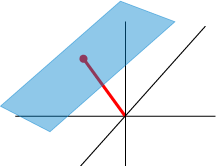Section4.1Portfolio 4
¶Portfolio 4: Eigenvectors and Similarity is due to Blackboard by 11:59 p.m. Friday, August 3rd.
Subsection4.1.1Purpose and Learning Standards
In the fourth portfolio you'll gain the tools to "take apart" a square linear transformation to discover its geometric effects -- and (hopefully) find a basis on which its action is quite simple. You'll leave the matrix-vector equation \(A{\bf x} = {\bf b}\) behind in favor of the eigenvalue-eigenvector equation \(A{\bf x} = \lambda{\bf x}\text{,}\) and where invertibility was once our top priority, singularity (non-invertibility) will now be the name of the game.
The learning standards included in this portfolio are:
- 4.A Determine the eigenvalues of a square matrix and their multiplicities, by finding and solving its characteristic polynomial equation.
- 4.B Determine eigenvectors of a matrix associated to a given eigenvalue, and (where appropriate) a basis for the associated eigenspace.
- 4.C Classify the geometric effects of a given linear transformation usings its eigenvalues and eigenvectors, and use diagonalization to "custom-make" a matrix with desired effects.
- 4.X Demonstrate theoretical connections between eigenvalues/eigenspaces and other important properties of square matrices.
Subsection4.1.2Skills You'll Develop
In this portfolio you'll gain practice with the following skills that will not only promote your success in linear algebra, but grow as practitioners of pure and applied mathematics.
- Determine the eigenvalues of a square matrix.
- Determine eigenvectors associated with given eigenvalues, when possible finding a basis for the domain of a transformation that consists entirely of its eigenvectors.
- Decompose a linear transformation into scalar actions on subspaces of its domain, and describe its action on those subspaces geometrically.
- Use eigenvalues and eigenvectors to determine a diagonalizing factorization \(P^{-1}DP\) for a diagonalizable matrix.
- Write clear, careful proofs of elementary mathematical facts that connect two or more related properties of a matrix (or vector space or linear transformation).
Subsection4.1.3Knowledge You'll Gain
In this portfolio you'll gain familiarity with the following important content knowledge of linear algebra.
- Characteristic polynomial
- Eigenvalues
- Eigenvectors / eigenspaces
- Diagonalizable matrix / eigenbasis
- Diagonalizing factorization
- Algebraic multiplicity of an eigenvalue
- Geometric multiplicity of an eigenvalue
- Dilation / contraction
- Reflection
- Rotation
- Projection
- Shear
- Markov matrix
Subsection4.1.4Tasks
You'll demonstrate that you've fulfilled the purpose of this assignment by completing the following sets of tasks. Each type of task will generate an artifact that you can include in your portfolio.
- Begin your Learning Narrative 4 (click here for more information)
- Engage regularly with your classmates through reading discussions, Flipgrid assignments, Piazza discussions, and/or online gatherings.
- Practice problem solving in WeBWoRK (click here to access)
- Submit, and revise based on feedback, quizzes and exams via Blackboard (click here to access)
- Type up, and revise based on feedback, solutions to a selection of proof exercises via Blackboard (click here to access)
- Complete the second Pecha-Kucha project (click here for more information) and submit video to Blackboard.
- When finished with the above, complete your Learning Narrative 4 (click here 3 for more information).
- Finally, submit your finished portfolio by the due date via Blackboard (click here to access).
Subsection4.1.5Criteria for Success
Your portfolios in this course are the primary component on which you are graded. Accordingly, your portfolio must contain evidence that you have done each of the following:
- Met each computational learning standard listed above (4.A, 4.B, 4.C). For each standard, evidence must include one or more quizzes, exam problems, and/or copies of fully worked-out sets of WeBWoRK exercises related to these standards.
- Met each conceptual learning standard listed above (4.X). Evidence must include your typeset proof portfolio problems (as a PDF).
- Engaged with your classmates around coursework. Evidence must include screenshots or printouts of one or more discussions within reading annotations or on Piazza, and/or a discussion of your contributions to video boards or online hangouts.
- Reflected on the progress of your own learning. Evidence must include your Learning Narrative at the front of your portfolio, which explicitly references how the other evidence in your portfolio supports your having done all of the above.
